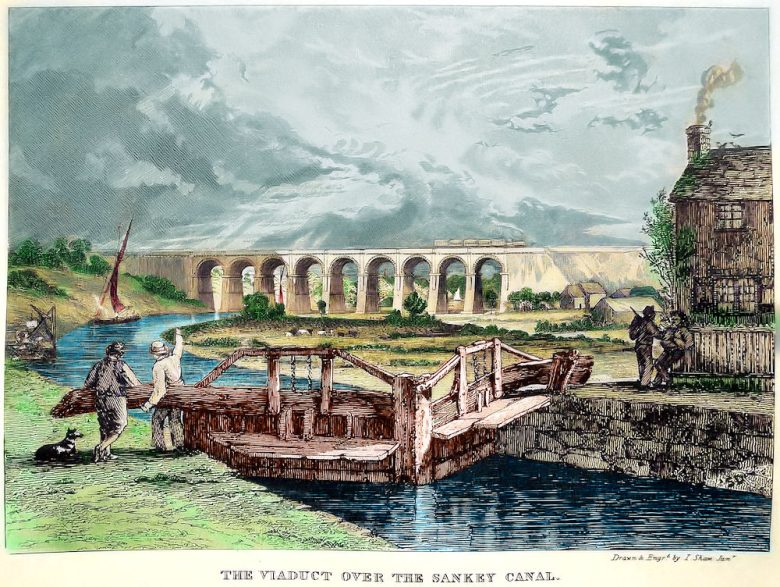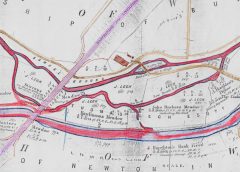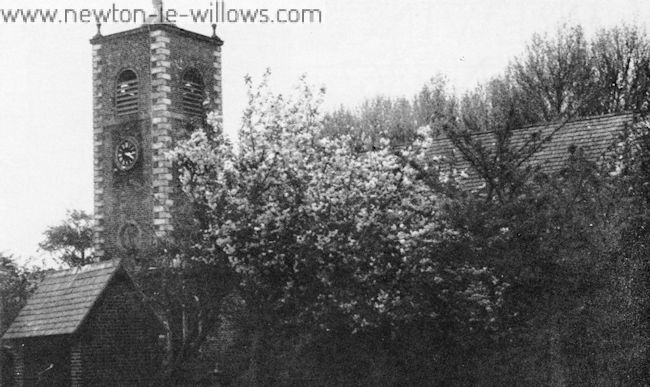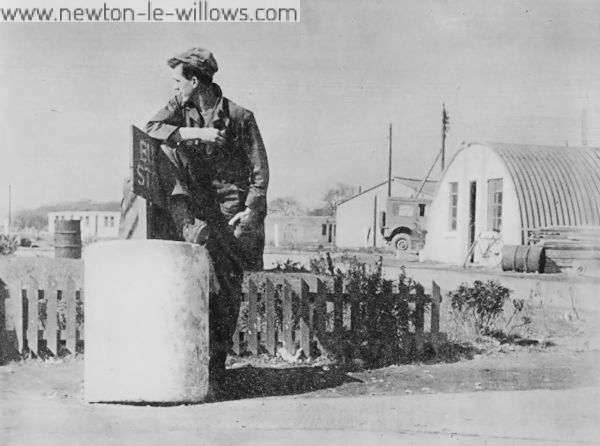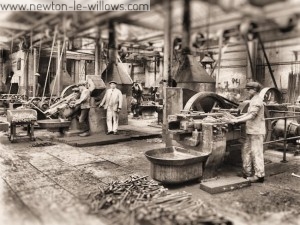Haydock Historic Characterisation project from 2011 conducted by National Museums Liverpool and English Heritage Township: Haydock Geology: The solid geology is coal measures sandstone overlain by drift deposits of boulder clay. Historic Core: According to the OS 6 1st Edition map, the main historic core of Haydock appears to have been based at Haydock Town and Old Boston. Linear settlement development also exisits between Haydock Green and Old Boston. Haydock Green is named and depicted on Greenwood(1818) and Hennet (1830) maps. Only the township of Haydock is named on Hennet…
Read More >>A History of Burtonwood.
Burtoneswod, 1228; Bourtonewod, 1251; Burtonwode, 1297; Bortounwod, 1337. This township, of 4,192½ statute acres, (1) was long purely agricultural in character. The population has recently increased at a rapid rate, and in 1901 numbered 2,187 persons. The country is extremely flat, with much reclaimed marsh or mossland, drained by ‘cuts’ into the Sankey Brook, which, winding from north to south-east and south, forms the boundary of the township on those sides. It yields crops of wheat, clover, and hay, and some potatoes and turnips on a clay soil; but on…
Read More >>History of Burtonwood Brewery
On March 13th, 1867, James and Jane Forshaw purchased the land on which the Burtonwood Brewery now stands. James had some brewing training while employed at the Bath Springs Brewery, Ormskirk, and probably chose the site because of its position mid-way between Warrington and St Helens, and also because there was an adequate supply of suitable water readily available. The first brewery had a 14-barrel open-tired copper, two 12-barrel Fer-menting Vessels and a cellar capacity for 45 barrels. The trade was with Free Houses, farmers and private landowners, mainly in…
Read More >>The Burtonwood Chapel
The Chapel of Burtonwood was founded by Sir Thomas de Bold in 1605, when Burtonwood was part of the Parish of Warrington. It was consecrated by the Rt Rev John Lord, Bishop of Chester, on 16th December 1634 in the presence of Richard Bold and Thomas Ireland of Bewsey. During the Commonwealth, Burton-wood became a separate Parish, and it must have excited many of the Americans who came to Burtonwood in World War II to discover that an early incum-bent of the Church, the Rev. Samuel Mather, had sailed to…
Read More >>The Story of Burtonwood
In the last 25 years the name of Burtonwood has been carried by thousands of American servicemen to countries all over the world. It is the only place in the British Isles to bear this name, and is possibly more widely known than Warrington, to which it was originally a subservient manor. THE WOOD BY THE TUN Probably the original name of Bur-tonwood was simply ‘Burton’, which means the ‘tun’, or farmstead, by a ‘burh’, or fortifiedmanor. The burh could have been the borough of Warrington. The wood, however, was…
Read More >>CASTLE HILL, Newton-le-Willows
1980’s Archaeological Excavations. he text for this post is transcribed from two pamphlets that where produced at the time of the 1980s digs at Castle Hill, to aid public understanding of the work that was being carried out by the archaeologists from Liverpool. Pamphlet #1 Having received permission from the Department of the Environment to excavate a scheduled ancient monument, a North West Archaeological Trust Community Programme is now in the process of investigating an earthwork at Castle Hill, Newton-le-Willows. Although this mound is a recognisable landmark and still stands…
Read More >>Burtonwood – The Truth About G.I. Town
Four miles from Warrington in Lancashire, is Burtonwood, the great maintenance base for the American Air Lift to Berlin. There several thousand young Americans, most of whom had never been overseas before, were dumped far from their homes with orders to keep the Dakotas, Skymasters and other aircraft flying through the air door in the Iron Curtain. The success of the Air Lift was apparent to all, but locally the social consequences were less happy for both sides. Six thousand American airmen dumped down suddenly to live near a bleak…
Read More >>The Vulcan Works – Making the Lion roar again
During the early part of 1979, Ruston Diesels Limited, the Company then occupying the historic Vulcan Foundry site, agreed to restore the locomotive Lion which had been a static exhibit for many years in the Transport Gallery of Liverpool Museum. This was to provide project work for apprentices and graduate trainees, and to enable Lion to participate in the forth-coming ‘Rocket 150’ celebrations. On 4 April, the engine arrived at Ruston’s looking rather incongruous on the back of an articulated lorry and during the next few weeks it was stripped…
Read More >>Southworth Burial Mound
I recently purchased a number of the Burtonwood Brewery in-house ‘Top Hat’ magazines from the 1980s, in one of them was this article concerning the excavation of the Southworth Burial Mound which is between Winwick and Lowton. Digging into the roots of history Remnants of a long-lost civilisation have been unearthed from plough-blade depth on open farmland, close to a huge man-made crater which will eventually accommodate colliery waste. And to mark the sensational discovery, being hailed as the North’s most important prehistoric find of the last decade, the archaeology…
Read More >>Steam-Boiler Explosion at Newton
There was a Great Loss of Life by a Steam-Boiler Explosion at Newton.. 22nd Sept 1838 We regret to inform that the Viaduct Foundry on the Manchester & Liverpool Line of Railway at Newton in the Willows, the property of Messrs, Jones, Turner, and Evens, was on MOnday morning last the scene of a dreadful and fatal steam-boiler explosion, by which eight persons are already dead, and two others are lying without much hope of recovery. It appears that Messrs Jones & Co. employ about 200 men, and in the…
Read More >>Earlestown War memorial – unveiled by Lord Newton.
On Saturday afternoon, at Earlestown, Lord Newton unveiled a memorial of the South African war, which has been erected outside the Town Hall in honour of fifty men of Newton-in-Makerfield who volunteered for service in that historic struggle. The cost of the monument, about £360, is defrayed out of the local fund started in 1899 for the relief of necessitous cases arising out of such service. Much of the money was contributed by working men, and happily out of £991 raised it was found necessary to distribute only £215 in…
Read More >>ST, Oswald’s, Winwick.
There is no beginning to the istory of Winwick. It goes beyond the Fourteenth Century to the earliest days of the English, to a time “when a King of Mercia was resisting evangelisation with free slaughter; and then, when we seem to have come to the birth of the ancient Saxon village, we see it again in a remoter vista, shining magically in the opal light of legend. The learned Usher thought that Winwick was Caer Gwentquic, one of the twenty cities collected by the monk Gildas out of Nennius;…
Read More >>George & Robert Stephenson
THE LIFE OF George Stephenson and his son Robert Stephenson Comprising also a history of the invention and introduction of the railway locomotive. By Samual Smiles With Portraits and Numerous Illustrations. [iii] PREFACE. The present is a revised edition of the Life of George Stephenson and of his son Robert Stephenson, to which is prefixed a history of the Railway and the Locomotive in its earlier stages, uniform with the early history of the Steam-engine given in vol. iv. of “Lives of the Engineers” containing the memoirs of Boulton and…
Read More >>The Public Library – Crow Lane, Newton
The first library in Newton-in-Makerfield was, we believe, the one in connection with the Mechanics Institute held at the Printing Works. It contained some 400 volumes, which had a fair number of readers. Adult members paid 2s. 6d per quarter, 1s 6d. to the library, and 1s to the newsroom; junior members paid 1s. 3d. per quarter, 9d to the library and 6d to the newsroom. In the first quarter (April, May, June, 1853) there were 41 members. In 1868 the now extensive library in connection with the Viaduct Institute,…
Read More >>Autobiography of Garret Ronayne
An old Indian Mutiny Veteran, who served diligently and faithfully throughout the mutiny of 1857-1858. Having been asked by several, of my friends to give a short sketch of my eventful career, I have pleasure in dedicating to them my autobiography in the hope that they will at last confirm a statement I have often made, that I am a most singular man. As it is about fifty-eight years ago since my enlisting in the army, I must respectfully request that my readers will forgive me for any mistakes I…
Read More >>
